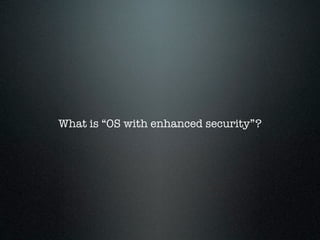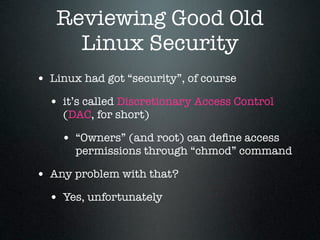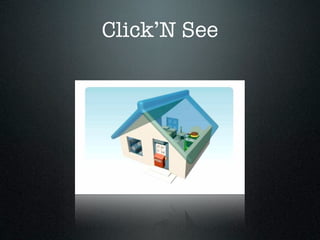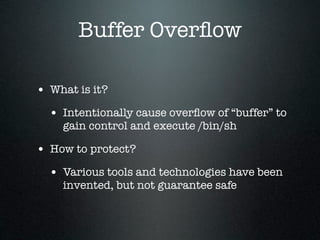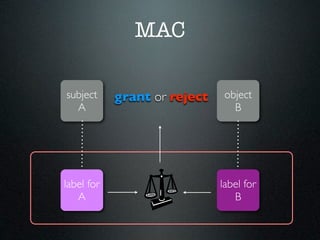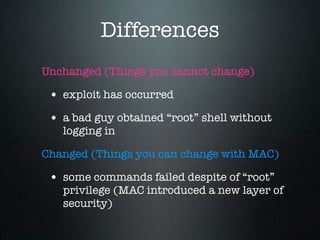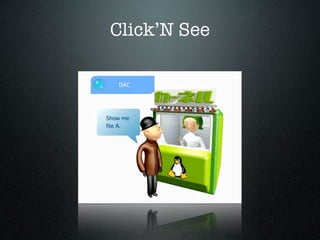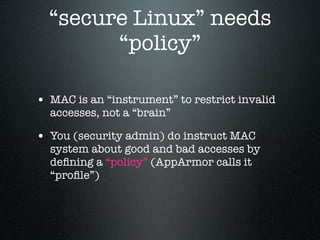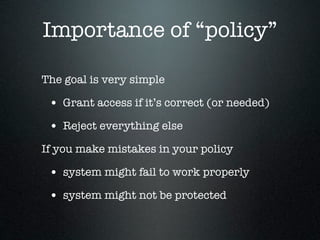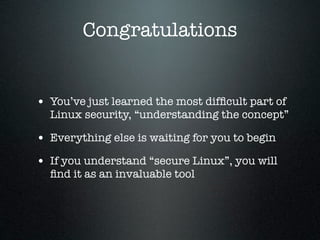Your First Guide to "secure Linux"
- 1. Your First Guide to ”secure Linux” August 12, 2010 Toshiharu Harada [email protected] NTT DATA CORPORATION
- 2. Abstract There are two types of people in the world. Those who are security experts, and the remainder of the world. In most cases, security experts are willing to provide technical assistance to people, but this does not always work as the information can be highly technical and confusing if you are not comfortable with the fundamentals of Linux security. Toshiharu Harada, Project Manager for TOMOYO Linux at NTT DATA CORPORATION will share the fundamental concepts of "secure Linux" for managers and end users who have little or no familiarity with security. This session does not require any special skills or knowledge, and is *not* designed for security experts.
- 3. Excuse me, Hey! why you look so I just found a happy? terrible vulnerability!
- 4. Aren’t you having fun? Deadly wrong, everything is just for you
- 5. Prologue "Whenever people agree with me, I always feel I must be wrong” -- Oscar Wilde
- 6. “secure Linux” is a Linux version of “OS with enhanced security”
- 7. What is “OS with enhanced security”?
- 8. You can Google it as always, but what you get will be much more than you want (and hard to understand)
- 9. If you ask “security people” ... You’ll get the same results in 3D
- 10. • Tons of information on the net ... • Open source implementations available ... • Active and friendly community ... What’s the missing link?
- 11. Maybe the missing link is the “concept” of “secure Linux” So, here I am
- 12. Who Am I? • Project manager of TOMOYO Linux, one of the “secure Linux” extensions part of the upstream • When I launched TOMOYO project in 2003, I started investing of the existing projects • Thanks to many people, TOMOYO has been incorporated in the mainline Linux kernel
- 13. This presentation is intended to provide you the fundamental concepts of • what “secure OS” is • why it has to be developed
- 14. What You Get Understanding the underlying concepts of “secure Linux” should help you • to enlarge your administrative knowledge and experience • to make a good decision on when and how you need it • to protect your system (someday)
- 15. “secure Linux” is • a name for Linux version of “secure OS (operating system)” • Linux has three “secure Linux” extensions: SELinux, SMACK and TOMOYO currently, and AppArmor (to be merged for 2.6.36)
- 16. Pros of “secure Linux” • It can reduce the potential damages to your Linux system when it gets exploited • So, let’s start with “exploits”
- 17. Chap. 1 Exploits "Give me a place to stand on, and I will move the Earth.” -- Archimedes
- 18. Wisdom from Microsoft Security Response Center
- 19. Law #1 “If a bad guy can persuade you to run his program on your computer, it’s not your computer anymore” • Actually, a bad guy can run his program on your computer without persuading “you” • That’s what we call an “exploit”
- 20. What is an “exploit”? From Wikipedia (as of July 15th, 2010) • An exploit is a piece of software, a chunk of data, or sequence of commands that take advantage of a bug, glitch or vulnerability in order to cause unintended or unanticipated behavior to occur on computer software, hardware, or something electronic (usually computerised). • This frequently includes such things as gaining control of a computer system or allowing privilege escalation or a denial of service attack.
- 21. Bad luck aspect of computer science From “10 Immutable Laws of Security by Microsoft” Law #1 • “It’s an unfortunate fact of computer science: when a computer program runs, it will do what it’s programmed to do, even if it’s programmed to be harmful.”
- 22. Exploits Demo • Understanding the meaning of “exploit” helps you to understand what “secure OS” is • Let’s see three examples
- 23. (1) ftp exploit
- 26. Know Thy Enemy • Typical procedures of exploits 1. Connect to a server pretending a normal client 2. Check to see if a server is a vulnerable one 3. Cause “misbehavior” by buffer overflow and other technique • Their goal is gaining the root privilege
- 27. Chap.1 Summary • Exploits are based on vulnerabilities • Vulnerabilities are common and your systems is exposed to many risks • Exploits aim to obtain root privilege of your system in the most cases
- 28. Chap. 2 Linux Security “With great power, comes great responsibility” -- Peter Parker
- 29. Reviewing Good Old Linux Security • Linux had got “security”, of course • it’s called Discretionary Access Control (DAC, for short) • “Owners” (and root) can define access permissions through “chmod” command • Any problem with that? • Yes, unfortunately
- 30. Problem with DAC • Root user can violate DAC settings • DAC cannot help when ... • your server is exploited • a bad guy manages to login your server as root • It’s useless against exploits
- 31. What about Firewalls and IDS? Can they compensate DAC shortage?
- 32. Firewall and IDS • Firewall • Exploits pretend to be good clients and try to connect through opened ports • IDS • IDS can’t recognize unknown/future attacks and vulnerabilities
- 33. Click’N See
- 34. Buffer Overflow • We learned that DAC and other traditional Linux security are not quite dependable • Suppose “buffer overflow” is a typical approach of attacks, can we prevent them causing “buffer overflow”?
- 35. Click’N See
- 36. Buffer Overflow • What is it? • Intentionally cause overflow of “buffer” to gain control and execute /bin/sh • How to protect? • Various tools and technologies have been invented, but not guarantee safe
- 37. Chap. 3 MAC "Although the world is full of suffering, it is full also of the overcoming of it.“ -- Helen Keller
- 38. Origins of secure OS • In ‘80s, research has been made in the USA, to define evaluation criteria for trusted computer systems • DoD unveiled “Trusted Computer Systems Evaluation Criteria” (TCSEC, aka “Orange Book”) in 1985
- 39. 1985
- 40. Amiga 1000 was released in 1985
- 41. TCSEC (TRUSTED COMPUTER SYSTEM EVALUATION CRITERIA) Trusted Computer Systems should have ... Division A and “Verified Protection” Division B and “Mandatory Protection” Division C “Discretionary Protection” Division D “Minimal Protection”
- 42. DAC defined by TCSEC • “The TCB* shall define and control access between named users and named objects in the ADP* system.” • “The enforcement mechanism shall allow users to specify and control sharing of those objects by named individuals or defined groups or both.” • TCB: Trusted Computing Base, ADP: automatic data processing ( you don’t have to remember these terms, I think)
- 43. DAC read object write execute user group others (self)
- 44. DAC % chmod 600 my_file read object write execute user group others (self)
- 45. MAC • MAC (Mandatory Access Control) can improve the situation which DAC cannot solve
- 46. MAC defined by TCSEC • “The TCB shall enforce a mandatory access control policy over all subjects and storage objects under its control.” • “These subjects and objects shall be assigned sensitivity labels that are a combination of hierarchical classification levels and non- hierarchical categories, and the labels shall be used as the basis for mandatory access control decisions.”
- 47. MAC subject grant or reject object A B label for label for A B
- 48. NSA SELinux FAQ Security of Linux system depends ... 1. Unmodified Linux system 2. Linux system with MAC
- 49. Security of “Unmodified Linux System” se curity privileged applications correctness of the kernel
- 50. Security of “Linux System with MAC” security security policy correctness of the kernel MAC
- 51. How MAC can help? (samba exploit vs. TOMOYO)
- 52. Differences Unchanged (Things you cannot change) • exploit has occurred • a bad guy obtained “root” shell without logging in Changed (Things you can change with MAC) • some commands failed despite of “root” privilege (MAC introduced a new layer of security)
- 53. Click’N See
- 54. Chap. 4 “Policy” God, give us grace to accept with serenity the things that cannot be changed, Courage to change the things which should be changed, and the Wisdom to distinguish the one from the other. -- Reinhold Niebuhr
- 55. “secure Linux” needs “policy” • MAC is an “instrument” to restrict invalid accesses, not a “brain” • You (security admin) do instruct MAC system about good and bad accesses by defining a “policy” (AppArmor calls it “profile”)
- 56. Importance of “policy” The goal is very simple • Grant access if it’s correct (or needed) • Reject everything else If you make mistakes in your policy • system might fail to work properly • system might not be protected
- 57. The Serenity Prayer O God, give us grace to accept with serenity the things that cannot be changed, Courage to change the things which should be changed, and the Wisdom to distinguish the one from the other
- 58. The Security Prayer (with my deepest respects for Reinhold Niebuhr) O God, give us grace to accept with serenity the things that are needed, Courage to reject the things which are not necessary, and the Wisdom to distinguish the one from the other
- 59. Where to find the wisdom? SELinux has a “reference policy” • “that embodies the built-up knowledge over the years about what accesses are in fact required for a large body of software” • novice users can start with “Boolean” and power users can maintain their own foundation TOMOYO and SMACK • “Do it yourself”
- 60. “Domain” • No program is always good or always bad • Therefore, security policies are the set of security contexts (conditions) • SELinux and TOMOYO call them “domains” (AppArmor call them “profiles”)
- 61. “Domain” “Granularity” of MAC policy is determined by two factors • “domain” granularity • access control granularity for each domain Both live in the kernel space, not in the userspace
- 62. userspace kernel
- 63. Managing Policy What and When • Give permissions only when they are needed • Delete permissions if they turned out to be unnecessary How • Carefully monitor the logs
- 64. Managing Policy Cautions • a policy “error” is detected/defined when a access occurs but its definition is missing among policy rules • you can add such an error definition to the policy, in fact transforming it into policy rule, so that the same error will not occur anymore • if you repeat this step thoughtlessly, you will lose control
- 65. “Policy Auto Learning” What is it? • Feature available with AppArmor and TOMOYO How it works? • Observing executions of system call • Transform results into the policy rule (like audit2allow does for SELinux)
- 66. Results of policy auto learning • can never be perfect • has no logics • should be considered as a starting point Auto learning feature can be used as an analysis tool or an educational tool
- 67. References Live as if you were to die tomorrow. Learn as if you were to live forever. -- Mahatma Gandhi
- 68. For Comprehensive Understanding of Linux Security Ideal reference by James Morris, who is the Linux kernel security subsystem maintainer; author of the kernel cryptographic API; and a leading contributor to the SELinux, Linux Security Module, Netfilter and IPsec projects.
- 69. Linux Kernel Security Wiki Best place to find Linux kernel security related projects
- 70. To Know Your Enemy • “Apache.org services attacked” (April 13, 2010) http://lwn.net/Articles/383260/ • “Changes to LoCo Server Policy” (August 11, 2007) https://lists.ubuntu.com/archives/loco-contacts/ 2007-August/001510.html • “Debian server compromise” (July 12, 2006) http:// www.debian-administration.org/articles/417
- 71. Find the Code Linux Cross Reference
- 72. TCSEC to ISO/IEC 15408 • TCSEC has expired and the current standard is ISO/IEC 15408 • Functional requirements have been described as “protection profile” • LSPP (Labeled Security Protection Profile) succeeds MAC in TCSEC
- 73. Standards • National Security Institute - 5200.28-STD Trusted Computer System Evaluation Criteria • ISO/IEC 15408 • CAPP: “Controlled Access” protection profile • LSPP: “Labeled Security” protection profile
- 75. Other Topics
- 76. Secure Embedded Linux Characteristics of embedded devices • Dedicated for usages and built with minimum resources • Mass production affects cost (recall for millions, for instance) • Network/HD/Updates might not always be available Linux has been spreading for embedded devices
- 77. Secure Embedded Linux Google’s Android and Chromium OS are adding unique modifications to improve security
- 79. “Cloud” • Guest OS runs as a process from host OS / hypervisor • Internal activities of guest OS are translated, so host OS can hardly monitor and confine them • Guest OS share the NIC, HD and other devices, so physically reachable each other
- 80. “Cloud” Commonly used virtualization library “libvirt” has been incorporated the results of “sVirt (secure virtualization)”
- 81. Congratulations • You’ve just learned the most difficult part of Linux security, “understanding the concept” • Everything else is waiting for you to begin • If you understand “secure Linux”, you will find it as an invaluable tool
- 82. “Loving can cost a lot, but not loving always costs more.” -- Merle Shain
- 83. Why not starting today?
- 84. The Serenity Prayer by Reinhold Niebuhr (1892-1971) God, give us grace to Taking, as Jesus did, This accept with serenity the sinful world as it is, Not as things that cannot be I would have it, changed, Trusting that You will Courage to change the make all things right, If I things which should be surrender to Your will, changed, and the Wisdom to distinguish the one from So that I may be the other. reasonably happy in this life, And supremely happy Living one day at a time, with you forever in the Enjoying one moment at a next. time, Accepting hardship as a pathway to peace, Amen
- 85. Contact Information My e-mail: [email protected] I’m sharing slides at SlideShare as “haradats” • Selected presentations of my project and TOMOYO Linux and my own experiences
- 86. The latest version of these slides can be found at SlideShare Acknowledgements Special thanks to Giuseppe La Tona, Tetsuo Handa for reviewing and Stephen Smalley for correcting SELinux related information Trademarks Linux is a registered trademark of Linus Torvalds in the United States and other countries TOMOYO is a registered trademark of NTT DATA CORPORATION in Japan







